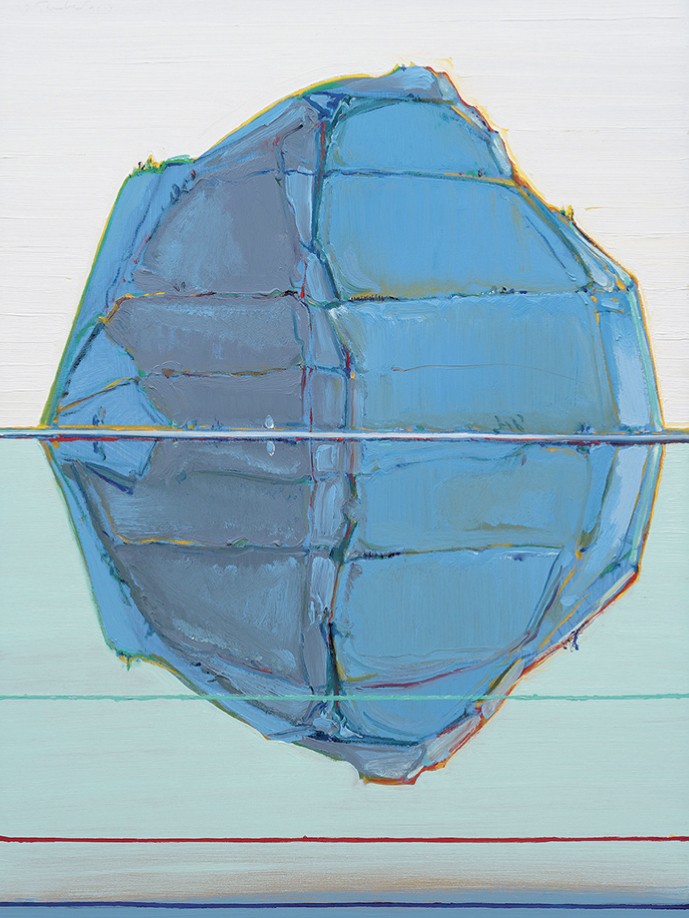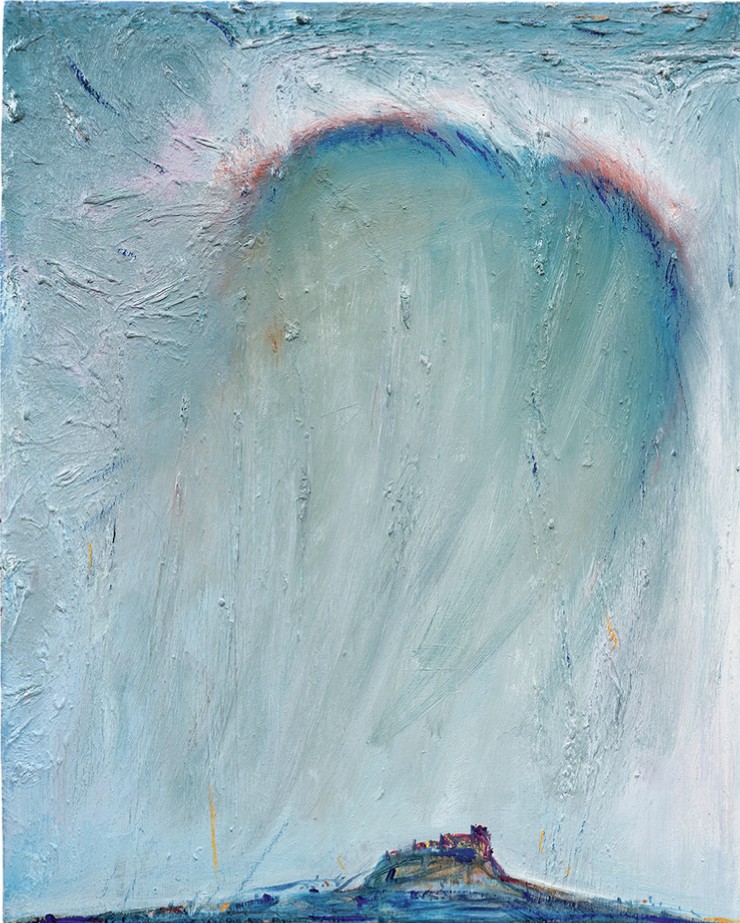Wayne Thiebaud
Accompanied by a small group of drawings, “Mountains 1965–2019” was a show of landscape paintings by Wayne Thiebaud, ranging across the titular span, at Acquavella Galleries in Manhattan, in November and December of 2019. The consistency of the motif and style of the work was such that the viewer could be forgiven for failing to guess which piece came from what year. The artist is best known, from as early on as the 1950s and ’60s, for his pre-pop art paintings of cakes, pies, restaurant counters and gum ball machines, set in shallow, flattened but realistic spaces, looking like a cross between lush food photography and rich painterly abstractions, balanced right in the middle. If Thiebaud’s iconic still life works seem (among many other qualities and characteristics) to possess a complex but clear relationship to marketing and advertisements, and to update classic European bourgeois still life painting in sharply American terms, then his landscapes are equally American but completely other in rhetorical stance. Coming out of Bay Area figuration in contemporary terms, they also have a significant relationship to, and ancestry from, the 19th-century influence of luminism and the American Sublime, with strong elements of the 20th century’s takes on depicting nature as well, from Edward Hopper to Milton Avery as touchstones. And while the North America of big landscapes and open spaces, capitalism and commercial products, advertising and display, connects Thiebaud’s interests in landscape and still life, he gives the viewer an altogether different angle on things when he trains his eye outside, and into the searing light of the west coast mountain ranges he still loves to paint.

Wayne Thiebaud, Lake Mountain, 2019, oil on canvas, 48 x 36 inches. © Wayne Thiebaud/ Licensed by VAGA at ARS, New York. All images courtesy Acquavella Galleries, New York, NY.
Thiebaud’s work gives a deep and unique form of pleasure to the viewer. The work appears easy to pigeonhole but in fact is confident enough to allow misunderstanding, and no other artist combines his major ingredients, and certainly not in anything like the same way. Comprehensive formal rigour and technical mastery of alla prima impasto brushwork do not easily meld with his winking, celebratory sense of humour, or with his deeply felt, calm, go-your-own-way California spirituality. Thiebaud makes seeming paradoxes into obvious bedfellows, and has created a culture of his own. It might sound exaggerated, but he is a kind of sage of the inside and the outside, an artist whose work is both knowing and questioning, critical and accepting at once, open in vision, while remaining highly clued in. The venerable Californian, now less than a year away from his 100th birthday, is still hard at work in the studio and a genuine example of ageless artistic vitality. His characteristic brushwork—lusciously expressive but judiciously controlled—is still in clear evidence and is as beautiful as ever, if not more so, as seen in the most recent pieces at Acquavella.
His landscape paintings, initially misunderstood by some and substantially underrated, with respect to his still life works, have long been a crucial element of his production and in some respects represent the equal half-share of his overall achievement. Seeming to some observers as both divergent and minor compared with his iconic still life work, the landscapes were misread as conservative and sentimental, tacky even, by some critics. That view was sorely mistaken. Deeply moving and intuitive, resonant images of west coast, mostly Californian vistas, these works going back decades are some of the most deeply felt and sensitive images of the natural world and its intersection with human construction that have been done in recent years. They were made in the face of strongly condemning, officially disapproved attacks on landscape painting in the first place. Influenced by his friend Richard Diebenkorn, Thiebaud nonetheless was the one to double down on making this kind of work in the 1960s, even when his colleague and exemplar Diebenkorn retreated into what was then a more accepted abstract mode. Thiebaud must have known what he was about, because he painted the mountains of California with a measured ecstasy, suffusing his pictures with a light that both accurately approximates and interpretatively unfolds his subject.

Passing Cloud, 2014/2019, oil on canvas, 30 x 24 inches. © Wayne Thiebaud/Licensed by VAGA at ARS, New York, NY.
The best paintings in the show (they’re all good, but a few recent ones are real killers) are like visions, semi-miraculous sites. Maybe the paintings in themselves are places of a kind, every one of them covered with an engrossing painting topography. Formally seen and made as all-over pictures, but still with each component part’s having been described with factual realistic seriousness, they are very impressive painting performances. Night Mesa, 2011–13, conjures its mountain with pathos and power, every application of surface and colour in perfect balance with one another, every stroke maximized. Canyon Pass, 2019, features a highway and horizon between two glowing blue cliffs, the expanse of space beyond an immensity in our field of vision, while retaining a remarkably coexistent flatness and self-referentiality of execution. Lake Mountain, 2019, shows a mirror image of the mountain above and below with magical gracefulness, registering the water in the bottom half with just a few crisp lines and mild colour differentiation. These are paintings that void the distinction between secular and sacred art, images of the world as more than one kind of world, the prosaic overlapping with the transcendent. Thiebaud turns up the temperature in Mountain Fire, 2019, simultaneously making us think about global warming and its terrible consequences (wildfires in California being particularly close ones for him), as well as of the archetype of the immanent mountain, a quasi-biblical image of both terrifying menace and spiritual salvation. ❚
“Wayne Thiebaud: Mountains 1965–2019” was exhibited at Acquavella Galleries, New York, from November 5 to December 13, 2019.
Benjamin Klein is an artist, writer and independent curator living and working in Montreal and Brooklyn.

